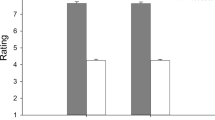Abstract
The aim of the present study was to explore whether females are specifically more facially reactive than males, or whether females are more emotionally reactive in general, as reflected even by non-facial reactions such as autonomic responding and emotional experience. Forty-eight females and 48 males were exposed to pictures of fear-relevant and fear-irrelevant stimuli while EMG activity was detected from the Corrugator supercilii muscle region. Skin conductance responses (SCRs) were measured, and the participants were also required to rate how unpleasant they experienced the stimuli to be. Fear-relevant stimuli evoked a larger corrugator response than fear-irrelevant stimuli, but only for females. Fear-relevant stimuli also elicited larger SCRs and higher ratings of unpleasantness, but these measures were almost identical for females and males. The present results are consistent with the hypothesis that females are more facially reactive than males, but not more reactive in other respects.
Similar content being viewed by others
References
Brody, L. R., & Hall, J. A. (1993). Gender and emotion. In M. Lewis & J. M. Haviland (Eds.), Handbook of emotion (pp. 447–460). New York: Guilford Press.
Buck, R. (1984). The communication of emotion. New York: Guilford.
Buck, R., Savin, V., Miller, R., & Caul, W. (1972). Communication of affect through facial expressions in humans. Journal of Personality and Social Psychology, 23, 362–371.
Cacioppo, J. T., Petty, R. P., Losch, M. E., & Kim, H. S. (1986). Electromyographic activity over facial muscle regions can differentiate the valence and intensity of affective reactions. Journal of Personality and Social Psychology, 50, 260–268.
Dimberg, U. (1982). Facial reactions to facial expressions. Psychophysiology, 19, 643–647.
Dimberg, U. (1986). Facial reactions to fear-relevant and fear-irrelevant stimuli. Biological Psychology, 23, 153–161.
Dimberg, U. (1990a). Facial electromyography and emotional reactions. (Invited address given upon receipt of the Distinguished Scientific Award for an Early Career Contribution to Psychophysiology, 1988). Psychophysiology, 27, 481–494.
Dimberg, U. (1990b). Facial reactions to auditory stimuli: Sex differences. Scandinavian Journal of Psychology, 31, 228–233.
Dimberg, U. (1997). Facial reactions: Rapidly evoked emotional responses. Journal of Psychophysiology 11, 115–123.
Dimberg, U., & Lundquist, O. (1990). Gender differences in facial reactions to facial expressions. Biological Psychology, 30, 151–159.
Dimberg, U., & Thell, S. (1988). Facial electromyography, fear relevance and the experience of stimuli. Journal of Psychophysiology, 2, 213–219.
Fridlund, A. J., & Cacioppo, J. T. (1986). Guidelines for human electromyographic research. Psychophysiology, 23, 567–589.
Fridlund, A. J., & Izard, C. E. (1983). Electromyographic studies of facial expression of emotions and patterns of emotion. In J. T. Cacioppo & R. E. Petty (Eds.), Social psychophysiology: A sourcebook (pp. 243–286). New York: Guilford Press.
Hall, J. A. (1978). Gender effects in decoding nonverbal cues. Psychological Bulletin, 85, 845–857.
Hjortsjö, C. H. (1970). Man's face and mimic language. Malmö: Nordens Boktryckeri.
Kirk, R. E. (1968). Experimental design: procedures for the behavioral sciences. Belmont, CA: Wadsworth.
Lykken, D. T., Rose, R., Luther, B., & Maley, M. (1966). Correcting psychophysiological measures for individual differences in range. Psychological Bulletin, 66, 481–484.
Schwartz, G. E., Brown, S. L., & Ahern, G. L. (1980). Facial muscle patterning and subjective experience during affective imagery: Sex differences. Psychophysiology, 17, 75–82.
Schwartz, G. E., Fair, P. L., Salt, P., Mandel, M. R., & Klerman, G. L. (1976). Facial muscle patterning to affective imagery in depressed and nondepressed subjects. Science, 192, 489–491.
Author information
Authors and Affiliations
Rights and permissions
About this article
Cite this article
Thunberg, M., Dimberg, U. Gender Differences in Facial Reactions to Fear-Relevant Stimuli. Journal of Nonverbal Behavior 24, 45–51 (2000). https://doi.org/10.1023/A:1006662822224
Issue Date:
DOI: https://doi.org/10.1023/A:1006662822224




